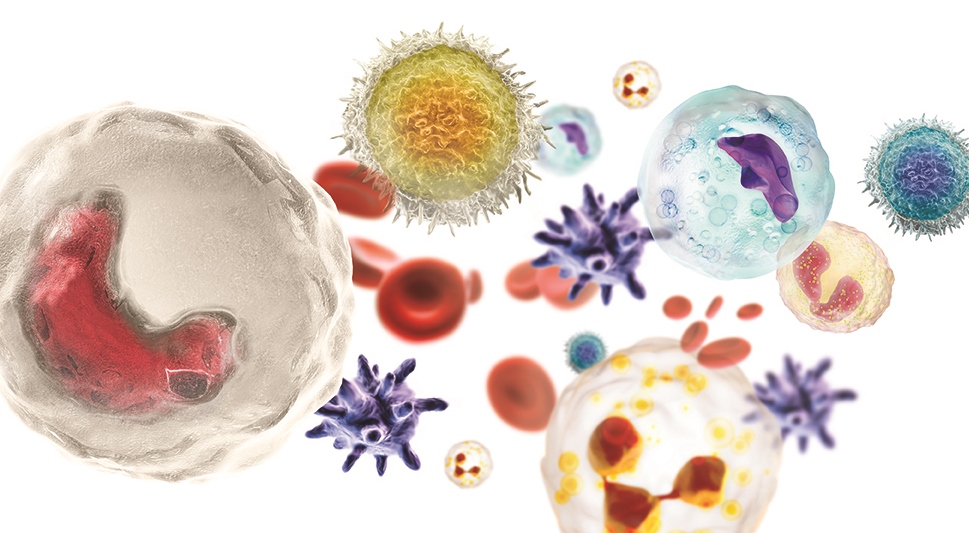Revealing the Secrets of Sepsis
Revealing the Secrets of Sepsis https://pediatricsnationwide.org/wp-content/uploads/2015/10/Pediatrics_Nationwide_feature_extra-art.jpg 969 533 Abbie Miller Abbie Miller https://pediatricsnationwide.org/wp-content/uploads/2023/05/051023BT016-Abbie-Crop.jpg- October 23, 2015
- Abbie Miller

Charting new territory in the understanding of how the immune system responds to sepsis.
Two children are admitted to the hospital with sepsis. Both receive antibiotics and fluid resuscitation within the critical first hour. Why does one get better after the initial crisis while the other goes on to develop additional infections and multiple organ failure?
This is the question plaguing critical care doctors and researchers around the world. The answer is as complex as the immune system itself.
Traditionally, doctors and researchers have understood that the comorbidities and signs and symptoms associated with sepsis all stem from an overactive immune response. The fever, high respiratory rate, low blood pressure and low organ perfusion associated with severe sepsis are all the result of an out-of-control immune response being waged against an infection.
But this is not the whole story.
While the body is waging war on the infection, it is also sending in the peacekeepers, the anti-inflammatory mediators meant to calm the immune system so that the body does not destroy itself. In a perfect situation, these two sides of the immune response to sepsis complement one another, defeating the initial infection, calming the overstimulated immune system and regaining homeostasis.
For some, however, homeostasis remains out of reach. Once the immune system is suppressed it stays suppressed and the patient is faced with nosocomial (hospital-acquired) infections, multiple organ failure and death.
The view that immunosuppression in the context of sepsis is real and is associated with poor outcomes is the result of 15 years of research that has caused a paradigm shift in research and critical illness care. Since the 1990s, researchers have been documenting and studying the phenomenon of immunoparalysis — extreme immunosuppression in the case of sepsis.
Critical care expert Mark Hall, MD, is leading the quest to solve the mystery of the immune response to critical illness in children by developing and refining tests to identify immunoparalysis and testing drugs to reverse it.
SEPSIS AND THE IMMUNE SYSTEM
“Sepsis is a systemic response to an overreaction of the immune system to an infection,” says Dr. Hall, principal investigator in the Center for Clinical and Translational Research in The Research Institute at Nationwide Children’s Hospital. “Over time, we evolved mechanisms for shutting down this overreaction of the immune system — an ‘off switch’ to shut down the inflammatory response. But in some cases, the switch stays off, and the patients experience nosocomial infections with no ability to fight them.”
After the on switch is triggered, causing the immune cells to release pro-inflammatory mediators to fight the infection, the off switch is then thrown, causing other immune cells to release anti-inflammatory mediators. When the anti-inflammatory response takes over, it can promote resolution of the acute phase of sepsis. But when the switch stays off, the effect can be disastrous.
“Sepsis results in a more severe immune loss than does HIV infection,” says Richard Hotchkiss, MD, professor of Anesthesiology, Surgery and Medicine atWashington University School of Medicine. “When a patient has an active HIV infection, they’re losing CD4+ T-cells. When a patient is septic, they are losing CD4+ and CD8+ T-cells, B-cells, dendritic cells, monocytes — a whole host of immune cells.”
Studies done in the pediatric intensive care unit (PICU) setting are providing pathologic findings very similar to what are seen in adult patients, says Dr. Hotchkiss. Lymphocytes are massively depleted in sepsis patients, regardless of age. Additionally, the types of organisms that trigger nosocomial infections in the newborn ICU (NICU) and PICU are often not very virulent, providing secondary evidence that the immune system has been suppressed, he continues.
UNINTENDED CONSEQUENCES OF CRITICAL CARE TREATMENTS
Beyond the immunosuppression caused by the immune system’s response to sepsis, a myriad of treatments provided in the ICU probably have unintended immunologic consequences, says Dr. Hall. Some medications, such as corticosteroids, transplant anti-rejection drugs and chemotherapy, are overtly immunosuppressive.
“Using anti-inflammatory medications in the setting of sepsis or other critical illness is something we need to think very carefully about,” says Jennifer Muszynski, MD, principal investigator in the Center for Clinical and Translational Research at The Research Institute. “It also needs to be the subject of ongoing research.”
Other drugs are usually considered benign when it comes to immune suppression — diuretics, sedatives, pain medication. But now, Drs. Hall and Muszynski believe these might also impair immune function.
“These medications are not used with the intent to modulate the immune system, but they likely are affecting it to some extent. We need to understand how much they are doing so,” Dr. Hall says. “Many critically ill patients are on a combination of all of these medications. Could the cumulative effect of these ‘benign’ medications impact the patient’s immune system in a way that affects outcomes? We don’t know yet, and we’re really just scratching the surface on our understanding of these relationships.”
In Dr. Muszynki’s lab, transfusion immunobiology is garnering attention as one area of research on the unintended consequences of traditional therapies. “By transfusing red blood cells in critically ill patients, are we unwittingly doing something to modulate the immune system?” she asks.
Intriguing evidence from her group and others so far suggests, “yes.”
In both in vitro and in vivo studies in critically ill children, the results suggest the way the cells are stored and how long they are stored may be associated with a perpetuation of immunoparalysis. “The studies are smaller but quite intriguing,” Dr. Muszynski says. “We’re seeing the same thing at the bench and the bedside. Moving forward, we need to look at larger groups to identify and understand the risk factors.”
For Drs. Hall and Muszynski, the results so far are enough to influence the way they treat patients. “Though we still transfuse some patients, we don’t transfuse as often as we used to,” says Dr. Hall.
IDENTIFYING IMMUNOPARALYSIS
While they may not be able to predict who will become immunosuppressed or how each of the treatments offered in the ICU will impact the immune system of each patient, Drs. Hall and Muszynski use two relatively simple tests to determine whether or not a patient is suffering from immunoparalysis. They look beyond cell counts and standard blood tests to assess how well the immune system is working.
The first test measures HLA-DR expression on monocytes. HLA-DR is an important immune system cell surface protein that is normally present on monocytes, but whose expression drops in the setting of immunoparalysis. The more HLA-DR the monocytes are expressing, the better the immune system is working, explains Dr. Hall.
“We stain whole blood and identify monocytes based on cell surface characteristics. Then we run the sample through a flow cytometer to quantitate the degree of expression of HLA-DR,” says Dr. Hall. “Thresholds have been identified below which patients are ostensibly at risk.”
The second test — the doctors’ preferred test — measures ex vivo LPS-induced TNF-alpha production capacity. TNF-alpha is a pro-inflammatory cytokine produced by monocytes. Lipopolysaccharide (LPS) — also known as endotoxin — induces an inflammatory response when it is mixed with blood cells. Sampled blood is mixed with LPS to induce cytokine production. Then, the amount of TNF-alpha produced is quantified using chemiluminescence.
“We have found over and over in single- and multicenter work in a wide variety of critical illness phenotypes in children that suppression of TNF production capacity is a bad thing, and severe suppression is a terrible thing with markedly increased risks for developing secondary infection and death,” says Dr. Hall.
The team at Nationwide Children’s has standardized their approach such that they now manufacture kits and send them to other institutions for multicenter work. “In one such study underway this summer, participating teams collect samples and ship the tests back to us overnight so that we can provide near-real-time information to drive therapy over the course of the study,” Dr. Hall says.
From a single-center perspective, Dr. Hall says, these are very feasible and high throughput tests. “For example, if we get a blood sample at 8 a.m., we can have results by 2 p.m.,” he explains. “This is very fast compared to traditional immune function tests.”
“Our work is not just about the lab. We are directly connected to the PICU,” says Dr. Hall. “In fact, we recently had a small lab for our work built on the PICU floor. This brings the tests needed for identifying immunosuppression literally steps away from the bedside. The faster we can identify immunosuppression, the faster we can begin using strategies to reverse it.”
TNF-alpha production capacity and HLA-DR expression form a nucleus of immune function testing that is missing from the clinical laboratory. “Our hope is that over time, using data we and others are collecting, these tests will move to the clinic and be used routinely,” Dr. Hall says.
This type of critical illness-induced immune suppression can, and does, occur in many types of critical illness. “As we show that this testing and intervention works, we can make the testing part of the routine workup,” says Dr. Hall.
“We think it’s particularly important to identify immunosuppression not only in septic infections but to prevent hospital-acquired sepsis,” Dr. Hall says. In the case of critically ill patients without sepsis, such as those recovering from trauma, early identification of immunoparalysis could help the medical team prevent infections that could lead to sepsis.
Identifying patients with immunoparalysis is just the beginning. Dr. Hall and his contemporaries believe that once identified, these patients can be helped by using drugs to boost their immune systems.
INNATE OR ADAPTIVE?
The two branches of the immune system, the innate and adaptive arms, are intricately intertwined. Though the cells of each branch have different targets, they are both critical to defending the body against infection. The innate immune system refers to monocytes, neutrophils, and the other nonspecific defense mechanisms that defend the body immediately, while the adaptive arm refers to lymphocytes, T-cells and B-cells, which are stimulated by signal cascades produced by the innate immune system to produce antigen-specific attacks.
In such a complex system, determining where to target therapies that boost immunity is not a simple task. “We think that if you stimulate the innate arm of the immune system, the rest of the immune cells will come along,” says Dr. Hall, who is also associate professor of Pediatrics, Division of Critical Care Medicine at The Ohio State University College of Medicine. “However, we understand that multiple approaches to immune system stimulation are likely to be optimal. It may also be true that you need to target both sides of the immune system to get optimal results.”
Drs. Hall and Muszynski are testing this hypothesis through numerous studies. In a small cohort, Dr. Muszynski looked at immune function in both arms of the immune system. She found that while septic children overall showed evidence of both innate and adaptive immune suppression, those children who went
on to develop persistent infections or new nosocomial infections had a suppressed adaptive immune system as measured by T-cell cytokine production. “We want to put things into nice little boxes — adaptive, innate — only to realize that those boxes don’t really exist, and it’s a bit more complex than that,” Dr. Muszynski says.
Dr. Hotchkiss agrees, “You can’t neatly separate the function of the two arms of the immune system.” But you do have to choose a target for therapies.
Dr. Hotchkiss’ work more directly targets the adaptive immune system by focusing on lymphocytes.
“Lymphocytes are master regulators of the immune cells,” he explains. “They are critical in controlling many facets of immunity. If you don’t get the CD4+ and CD8+ T-cells working, the other components are trying to function like they have one arm tied behind their back.”
REVERSING IMMUNOPARALYSIS
The mainstay for treatments for sepsis at this point is twofold: the prompt response to shock when it exists and prompt and accurate administration of antibiotics. “We’ve gotten pretty good treating the acute phase of sepsis,” says Dr. Muszynski. “Quality measures are underway to improve this further, but overall, we’re doing pretty well in that area.”
When it comes to immunoparalysis during the subacute phase of sepsis, however, the therapies with the most promise for treating immunoparalysis are not approved or available to patients.
“The greatest area for growth potential is the interventional arm of our research,” Dr. Hall says. “We believe immunoparalysis is reversible through drug treatment. And reversal will hopefully improve outcomes.”
Dr. Hall’s drug of choice for reversing immunoparalysis is granulocyte macrophage colony-stimulating factor (GM-CSF), a drug commonly used to treat neutropenia following chemotherapy. GM-CSF functions as a cytokine and stimulates the production of neutrophils and monocytes and also improves the function of immunoparalyzed innate immune cells.
In a small (14 patient) study, Dr. Hall and his team showed that patients who received GM-CSF showed immunoparalysis reversibility, had better outcomes and did not develop new infections.
“We have been working to evaluate GM-CSF as an immunostimulant in selected patients ever since,” says Dr. Hall, who is currently leading a clinical trial of the drug to prevent hospital-acquired sepsis in trauma patients.
Dr. Hotchkiss’ interventional work focuses on Interleukin-7 (IL-7), a drug that has been tested in more than 300 cancer and HIV+ patients to increase the number and activity of lymphocytes.
“IL-7 prevents cell death and promotes the proliferation of T-cells,” Dr. Hotchkiss says. “It has been effective with viral infections and shown some activity in cancer patients. This is an exciting drug and we’re going to see lots of trials with it in the future.”
Regardless which drug is being used, perhaps the biggest challenge in using drugs to modulate the immune system is getting the medications to the right patients.
“You might imagine that if you gave a drug to a whole bunch of people, only about half of whom actually needed it, then you’d be highly unlikely to see an effect of the drug on outcomes,” explains Dr. Hall of the mixed results immunomodulation has presented thus far. “Our approach is an individualized medicine approach.”
Dr. Hotchkiss agrees GM-CSF will likely have a role in treating immunosuppression in sepsis. “It hasn’t had great success in trials so far, but before we were giving it to everyone. Now that you can target immunosuppressed patients, the hope is that the right patients are getting the right drug and you’ll see better outcomes,” he explains.
PREDICTING THE FUTURE
Identifying and treating immunoparalysis in patients with sepsis and other critical illnesses will have a dramatic effect on outcomes for these patients.
But what if researchers can take it one step further? What if they could determine who is likely to go down the immunoparalysis pathway at the onset of their illness?
This is a direction for future research in this field.
“What predisposes patients to immune suppression? Is it the disease the patient came in with, is it the patient’s genetics? We don’t know,” says Dr. Hall. “A vast number of influences are acting on the patient at any point during his or her illness. It is difficult to predict who will go down the immunosuppression pathway.”
Other researchers in the field are working on just that. Hector Wong, MD, at Cincinnati Children’s Hospital Medical Center and his team are using genomic and proteomic biomarkers to predict which sepsis patients are likely to do well and which ones are likely to do poorly. According to Dr. Hall, a natural extension of this work would be to look for markers that predict sepsis phenotypes, including immunoparalysis.”
“Discovering how the individual host immune response contributes to differences in outcomes and how we can tailor our treatments to those differences is the next frontier in sepsis research,” Dr. Muszynski says.
References:
- Hall MW, Muszynski JA. Immune modulation in sepsis. Journal of Pediatric Infectious Diseases. 2009;4:127-136.
- Hotchkiss RS, Sherwood ER. Getting sepsis therapy right. Science. 2015 Mar 13;347(6227):1201-1202.
- Muszynski JA, Frazier E, Nofziger R, Nateri J, Hanson-Huber L, Steele L, Nicol K, Spinella PC, Hall MW; Pediatric Critical Care Blood Research Network (Blood Net) subgroup of the Pediatric Acute Lung Injury and Sepsis Investigators (PALISI). Red blood cell transfusion and immune function in critically ill children: a prospective observational study. Transfusion. 2014 Oct 29. [Epub ahead of print].
- Hall MW, Knatz NL, Vetterly C, Tomarello S, Wewers MD, Volk HD, Carcillo JA. Immunoparalysis and nosocomial infection in children with multiple organ dysfunction syndrome. Intensive Care Medicine. 2011 Mar;37(3):525-532.
- Muszynski JA, Nofziger R, Greathouse K, Steele L, Hanson-Huber L, Nateri J, Hall MW. Early adaptive immune suppression in children with septic shock: a prospective observational study. Critical Care. 2014 Jul8;18(4):R145.
- Sandquist M, Wong HR. Biomarkers of sepsis and their potential value in diagnosis, prognosis and treatment. Expert Review of Clinical Immunology. 2014 Oct;10(10):1349-1356.
Image credit: Nationwide Children’s
About the author
Abbie (Roth) Miller, MWC, is a passionate communicator of science. As the manager, medical and science content, at Nationwide Children’s Hospital, she shares stories about innovative research and discovery with audiences ranging from parents to preeminent researchers and leaders. Before coming to Nationwide Children’s, Abbie used her communication skills to engage audiences with a wide variety of science topics. She is a Medical Writer Certified®, credentialed by the American Medical Writers Association.
-
Abbie Millerhttps://pediatricsnationwide.org/author/abbie-miller/
-
Abbie Millerhttps://pediatricsnationwide.org/author/abbie-miller/
-
Abbie Millerhttps://pediatricsnationwide.org/author/abbie-miller/
-
Abbie Millerhttps://pediatricsnationwide.org/author/abbie-miller/
- Posted In:
- Features







